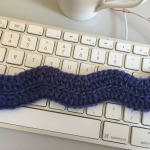And just like that, I’m back in cancer-land. I was cancer free for eight and a half years; long enough to make me feel that every damn cancer cell had been vanquished for good. Earlier this year, like just about everyone else, I had a lingering cough. It lasted through a few days at a music festival, a long drive to and from my uncle’s funeral in Brisbane and quiet festivities for Steve’s mother’s 90th birthday on the south coast. “Oh, that’s the hundred day cough!” people said. So I wasn’t particularly concerned, just tired of it, always on the lookout for a nice lozenge that would soothe my throat.
Then one day I was doing my usual walk that goes in a big loop past the dog pound, past the cows and alpacas, past the Catholic girls’ school, and through the soccer fields to join up with the road back home. I sometimes do this walk while talking on the phone to a friend who is also walking, in her case along the Linear Park Trail that follows the River Torrens through in Adelaide. This time, just past the dog pound, where the road goes up a bit of a rise, I found it hard to walk and talk at the same time. I was short of breath. I’d never felt out of breath on this stretch before. It was a bit of a worry. I mentioned it to my friend. We agreed I should see my doctor.
My GP ordered a chest scan. A few days later, I was fully expecting to be told I had walking pneumonia or something that could be zapped with a course of antibiotics. Turns out it was something far more sinister. A few blood tests and a CT scan later, Steve and I were back where we’d been nine years ago: shaking in our boots, staring at the doctor, receiving information that we were barely able to process. Damn. Back here. There was a week of Googling and worrying before we got in to see the medical oncologist in Orange, a town about 40 minutes’ drive to the west. The oncologist assured us that while the situation was certainly bad, it was not hopeless. Yes, my original cancer (primary peritoneal cancer, a form of ovarian cancer) had crept into my lungs when no-one was looking, but it was “eminently treatable” with a course of chemotherapy. “Eminently treatable” is a good pair of words. There are no guarantees in them, but room for hope. Buoyed up, I slid him a copy of my new novel, The Vitals. Not wanting to take up too much of his time – the waiting room was full of others in their own personal combinations of hope and fear – I gabbled about how, funnily enough, my cancer had come back just as my book about cancer was about to be launched! He leafed politely through the first few pages as we bundled ourselves out of the room.
The Vitals has a rabbit on the front cover (by Sandy Cull). This is because, in The Vitals, one of the tumours goes by the name of Bunny. Bunny’s replicating cells are getting ready to run free across the wide brown land of my body (okay, it’s fairly wide but not at all brown), dodging all attempts to eradicate them. The connection between rabbits and my cancer came early after my first cancer diagnosis in 2014, when I’d been told that one of my tumours inhabited a piece of territory in the female body called the pouch of Douglas. This territory was named after Dr Douglas, a “man midwife” in the era when midwifery, until then part of women’s business, was being taken over by (male) doctors. In London in 1726, Dr Douglas was invited to examine a certain Mary Toft, a poor woman who claimed to be able to give birth to baby rabbits. Toft was a national sensation, but Douglas was very suspicious. He soon outed her as a fraud who had been procuring baby rabbits, secreting them inside herself, and giving excellent performances of the birthing process.
The rabbits made me think of Ginge, a cat we knew when I was kid. Ginge’s mistress would say, “Go and catch a rabby, Ginge!” Yesterday, I started work on a crochet portrait of Ginge. It will be almost life-size, from a pattern. I need all the help I can get in catching rabbits.
Meanwhile, The Vitals is now on sale in bookshops across the land, or online.




